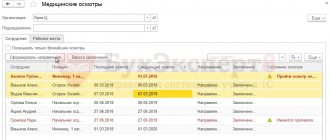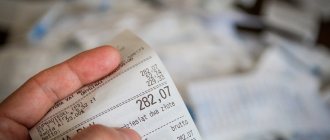Carrying out research, development and technological work (R&D) in-house or with the involvement of a third-party organization can lead to the emergence of an intangible asset (IMA) in accounting, if the rights to such an asset are documented. However, without documents or if a negative result is received in connection with R&D, we are no longer talking about intangible assets. Then expenses are taken into account in the manner established by PBU 17/02 “Accounting for expenses on research, development and technological work.” What are the features of this order?
R&D concept
The regulatory legal acts on accounting do not say what should be understood by R&D. The only mention is in PBU 17/02 , which states that for the purpose of applying this provision, research work includes work related to the implementation of scientific (research), scientific and technical activities and experimental developments, defined by the Federal Law of August 23, 1996 No. 127-FZ “On science and state scientific and technical policy” .
In accordance with Art. 2 of the said law, scientific (research) activities are recognized as activities aimed at obtaining and applying new knowledge. Thus, fundamental scientific research (refers to experimental or theoretical activity) is carried out with the aim of obtaining new knowledge about the basic laws of the structure, functioning and development of man, society, and the environment. Applied scientific research is aimed primarily at applying new knowledge to achieve practical goals and solve specific problems.
The purpose of scientific and technical activities is to obtain and apply new knowledge to solve technological, engineering, economic, social, humanitarian and other problems, to ensure the functioning of science, technology and production as a single system.
Experimental development is understood as an activity that is based on knowledge acquired as a result of scientific research or on the basis of practical experience, and is aimed at preserving human life and health, creating new materials, products, processes, devices, services, systems or methods and their further improvement.
From the presented definitions it follows that research work is associated with the acquisition and application of new knowledge, which can be used, for example, to create new materials and products.
Information about what should be considered R&D can also be gleaned from the Civil Code. According to paragraph 1 of Art. 769 of the Civil Code of the Russian Federation, scientific research work is scientific research, and development and technological work is the development of a sample of a new product, design documentation for it or new technology.
The presented calculations fit into the concepts used in IAS 38 “Intangible assets” . It is this standard that regulates, among other things, the procedure for accounting for research and development costs. Please note: according to international rules, all R&D that produces a positive result are recognized as intangible assets.
Based on paragraph 5 of IAS 38, the purpose of research and development is to obtain new knowledge. Research is original, planned research undertaken to obtain new scientific or technical knowledge. Examples of research activities are:
- activities aimed at obtaining new knowledge;
- search, evaluation and final selection of areas of application of research results or other knowledge;
- searching for alternative materials, devices, products, processes, systems or services;
- formulation, design, evaluation and final selection of possible alternatives to new or improved materials, devices, products, processes, systems or services.
Development refers to the application of research results or other knowledge in planning or designing the production of new or substantially improved materials, devices, products, processes, systems or services prior to their commercial production or use. Examples of development activities:
- designing, constructing and testing prototypes and models before production or use;
- design of tools, templates, forms and dies that involve new technology;
- designing, constructing and operating a pilot plant that is not of a scale that is economically feasible for commercial production;
- designing, constructing, and testing selected alternatives to new or improved materials, devices, products, processes, systems, or services.
When is PBU 17/02 applied?
This provision applies to R&D for which results are obtained (positive or negative):
- subject to legal protection, but not formalized in the manner prescribed by law. According to paragraph 1 of Art. 1225 of the Civil Code of the Russian Federation, the results of intellectual activity and equivalent means of individualization of legal entities, goods, works, services and enterprises that are provided with legal protection (intellectual property) are, in particular, inventions, utility models, industrial designs, selection achievements, topologies of integral microcircuits, production secrets (know-how). In cases provided for by the Civil Code, the exclusive right to a result of intellectual activity or a means of individualization is recognized and protected subject to state registration of such a result or means ( clause 1 of Article 1232 of the Civil Code of the Russian Federation );
- not subject to legal protection in accordance with the norms of current legislation.
PBU 17/02 does not apply to:
- unfinished R&D;
- R&D, the results of which are taken into account in accounting as intangible assets. Intangible assets include R&D that has produced a positive result and is formalized in the manner prescribed by law, if the conditions listed in clause 3 of PBU 14/2007 “Accounting for intangible assets” ;
- expenses of the organization for the development of natural resources (conducting geological studies of subsoil, exploration (additional exploration) of developed deposits, preparatory work in the extractive industries, etc.). In particular, PBU 24/2011 “Accounting for costs for the development of natural resources” . As stated in paragraph 7 of IAS 38 , exceptions to the scope of a standard may occur if the activities or transactions are so specialized that they give rise to matters requiring special treatment when recorded. ;
- costs for preparation and development of production, new organizations, workshops, units (start-up costs);
- costs for preparation and development of production of products not intended for serial and mass production;
- costs associated with improving technology and production organization, improving product quality, changing product design and other operational properties carried out during the production (technological) process.
Collecting expenses
Let us remind you that the provisions of PBU 17/02 do not apply to unfinished R&D. At the same time, as the Ministry of Finance indicated in Information No. PZ-8/2011 “On the formation in accounting and disclosure of information on innovation and modernization of production in the financial statements of an organization” (hereinafter Information ), PBU 17/02 , it can be used in relation to unfinished R&D in terms of determining the composition of costs that are subsequently included in the value of the resulting R&D asset.
According to clause 9 of PBU 17/02, R&D expenses include all actual expenses associated with the performance of such work. Here is a more detailed list of expenses, which includes:
- the cost of inventories and services of third-party organizations and individuals used in R&D;
- costs of wages and other payments to employees directly involved in performing R&D under an employment contract;
- contributions for social needs (including insurance contributions to state extra-budgetary funds);
- the cost of special equipment and special fittings intended for use as test and research objects;
- depreciation of fixed assets and intangible assets used in R&D;
- costs for the maintenance and operation of research equipment, installations and structures, other fixed assets and other property;
- general business expenses, if they are directly related to R&D;
- other expenses directly related to R&D, including testing costs.
Capital work and expenses that are not documented by acceptance certificates of fixed assets and other documents are classified as unfinished capital investments ( clause 41 of the Regulations on Accounting and Financial Reporting in the Russian Federation ).
Such investments are reflected in the balance sheet at the actual costs incurred by the organization. To account for expenses associated with R&D, the Instructions for using the Chart of Accounts propose using account 08 “Investments in non-current assets”, subaccount 08-8 “Performing research, development and technological work”.
Let's find out whether all R&D costs need to be accumulated in account 08, subaccount 08-8, in order to subsequently take into account the result of R&D as a non-current asset.
Accounting as part of other expenses
If the result of work performed is not recognized as an intangible asset (fixed asset item) and cannot be taken into account separately according to the rules of PBU 17/02, then the costs associated with R&D are included in other expenses of the reporting period in which the work was completed (was signed act of acceptance and transfer of work) (clause 7 PBU 17/02, clause 18 PBU 10/99).
Other expenses should include, for example, R&D costs that did not produce a positive result. In accounting, reflect such expenses by posting:
Debit 91-2 Credit 08-8 (23, 02, 10, 70...)
– expenses related to R&D are reflected in other expenses.
Moment of recognition of R&D expenses
Financiers drew attention to the fact that PBU 17/02 does not define the moment of commencement of recognition of costs that form the value of a non-current asset of the result of R&D ( clause 2 of the Information ). Officials consider it advisable in this regard to use the provisions of IAS 38 , which specifically identifies the problem associated with the fact that it is sometimes difficult to assess whether an independently created intangible asset meets the recognition criteria.
This may, for example, be due to the uncertainty of establishing when an identifiable asset will arise that will generate expected future economic benefits. To assess whether an independently created intangible asset meets the recognition criteria, by virtue of paragraph 52 of IAS 38, an enterprise must divide the process of creating an asset into two stages: the research stage and the development stage (examples of research and development activities are given above). Moreover, if it is impossible to separate the research stage from the development stage within the framework of an internal project aimed at creating intangible assets, the enterprise should take into account the costs of this project as if they were incurred only at the research stage.
An intangible asset that is the result of research (or the implementation of a research stage as part of an internal project) is not subject to recognition. Research costs are recognized as expenses when incurred ( paragraph 54 of IAS 38 ).
An intangible asset the result of development (or the implementation of a development stage as part of an internal project) is subject to recognition if and only if the enterprise can demonstrate ( paragraph 57 of IAS 38 ):
- the technical feasibility of completing the creation of the intangible asset so that it can be used or sold;
- intention to complete the creation of intangible assets and use or sell it;
- ability to use or sell intangible assets;
- how the intangible asset will create likely future economic benefits. Among other things, an entity may demonstrate the existence of a market for the product of the intangible asset or the intangible asset itself or, if the asset is intended to be used internally, the usefulness of such an asset;
- availability of sufficient technical, financial and other resources to complete the development, use or sale of intangible assets;
- the ability to reliably estimate the costs associated with intangible assets during its development.
Let's summarize. The Ministry of Finance proposes to recognize R&D expenses associated with conducting research in accounting at the time of their implementation and not include them in the value of a non-current asset. To determine when to begin including costs in the cost of this asset, one should be guided by signs indicating the likelihood of receiving economic benefits from the results of the work. R&D costs not included in the value of a non-current asset (research costs) are taken into account as expenses for ordinary activities or other expenses depending on their nature, conditions of implementation and areas of activity of the organization ( clause 4 of the Information ).
Please note: if R&D expenses were initially recognized as expenses of the current period, they cannot be recognized as non-current assets in subsequent reporting periods ( clause 8 of PBU 17/02 , clause 71 of IAS 38 ). This does not apply to cases of making an error that is subject to correction according to the rules of PBU 22/2010 “Correcting errors in accounting and reporting .
R&D result as an inventory item
According to clause 5 of PBU 17/02, information on R&D expenses should be reflected in accounting as investments in non-current assets.
Moreover, the unit of accounting for R&D expenses is an inventory object (the totality of expenses for work performed, the results of which are independently used in the production of products (when performing work, providing services) or for the management needs of the organization). It turns out that the R&D result is taken into account in account 08, to which we recommend opening an additional subaccount, for example, subaccount 08-9 “R&D results” (that is, the costs accumulated in subaccount 08-8 are written off to the debit of subaccount 08-9). R&D expenses (as a result of work performed) in accordance with clause 7 of PBU 17/02 are recognized in accounting if the following conditions are met:
- the amount of expenses can be determined and confirmed;
- there is documentary evidence of the completion of work (acceptance certificate for completed work, etc.);
- the use of work results for production and (or) management needs will lead to the receipt of future economic benefits (income);
- the use of R&D results can be demonstrated.
In the balance sheet, R&D expenses, if the information is material, are reflected in a separate group of asset items in the section “Non-current assets” ( clause 16 of PBU 17/02 ). In the form of the balance sheet, approved by Order of the Ministry of Finance of the Russian Federation dated July 2, 2010 No. 66n , for these purposes the line “Results of research and development” is provided (when submitting the balance sheet to state statistics bodies and other executive authorities, this line is assigned code 1120).
R&D expenses that do not produce a positive result are recognized as other expenses of the reporting period (Debit 91-2 Credit 08-8). We are talking about the reporting period, in which it becomes known that the work carried out did not lead to a positive result, that is, it will not be possible to obtain economic benefits (income) ( clause 19 of PBU 10/99 “Expenses of the organization” ).
Example 1
The company decided to develop a sample of a new industrial product on its own. The work carried out did not give a positive result. The enterprise's expenses amounted to 367,256 rubles, including materials 98,500 rubles, wages of employees 157,000 rubles, contributions for social needs (insurance contributions) 48,356 rubles, depreciation of fixed assets used in the performance of work , 37,000 rubles, for general business expenses directly related to the performance of work, 26,400 rubles.
The following entries will be made in the accounting records of the enterprise:
| Contents of operation | Debit | Credit | Amount, rub. |
| R&D expenses are reflected in the form of the cost of materials used | 08-8 | 10 | 98 500 |
| Wages accrued to employees who participated in the development of a sample of a new industrial product | 08-8 | 70 | 157 000 |
| Insurance premiums are calculated from the salaries of the above employees | 08-8 | 69 | 48 356 |
| Depreciation was accrued on fixed assets used in R&D | 08-8 | 02 | 37 000 |
| General business expenses directly related to R&D are reflected | 08-8 | 26 | 26 400 |
| Expenses incurred during the development of a sample of a new industrial product are included in other expenses as those that did not give a positive result | 91-2 | 08-8 | 367 256 |
The result of work is not recognized as an intangible asset or fixed asset
If the result of R&D cannot be recognized as an intangible asset or fixed asset, then the costs of such work are accounted for separately on account 04 “Intangible assets”. In this case, the following conditions must be met:
- the work was performed for production or management needs;
- the work must be completed, and the fact of completion must be documented (for example, an acceptance certificate for completed work);
- the amount of R&D expenses can be determined and documented;
- the use of R&D results will lead to economic benefits;
- the use of R&D results can be demonstrated;
- the result of R&D is not subject to legal protection or legal protection is not properly formalized (for example, if the invention does not require a patent or the organization for some reason did not patent its invention).
Such conditions are listed in paragraphs 2, 3 and 7 of PBU 17/02.
The following are not included in R&D expenses:
- work related to the development of natural resources;
- start-up work (costs for preparation and development of production of products, new organizations, workshops, units) - such expenses are not scientific achievements;
- work on the preparation and development of production of products not intended for serial, mass production;
- work to improve the technology and organization of production, improve the quality, design and other properties of products performed during the production process.
This is stated in paragraph 4 of PBU 17/02.
Until the results are obtained, R&D expenses are reflected in account 08 “Investments in non-current assets” (clause 5 of PBU 17/02). The corresponding account depends on the method of performing the work (the organization’s own resources or contracting). In this case the following transactions are carried out:
Debit 08-8 Credit 23
– reflects the costs of R&D carried out by its own special unit (for example, a scientific laboratory (bureau));
Debit 08-8 Credit 70 (10, 02, 68...)
– the costs of conducting R&D on the organization’s own resources are reflected (in the absence of a special unit);
Debit 08-8 Credit 60 (76)
– expenses for R&D carried out by the contractor are reflected.
After all the conditions for separate accounting of R&D expenses according to the rules of PBU 17/02 are met, the cost of work is written off from account 08-8 to a separate sub-account opened to account 04 “Intangible assets”. You can call this subaccount, for example, “R&D expenses.” When recognizing R&D expenses in accounting, make the following entry:
Debit 04 subaccount “R&D expenses” Credit 08-8
– R&D costs are taken into account.
This is stated in the Instructions for the chart of accounts (accounts 08, 04).
Write-off of the value of an asset as a result of R&D
Based on clause 10 of PBU 17/02, R&D expenses (the cost of the R&D result) are written off as expenses for ordinary activities from the 1st day of the month following the month in which the actual application of the results obtained in the production of products began (when performing work, provision of services) or for the management needs of the organization. Please note: this contains one of the fundamental differences from the procedure for writing off the value of intangible assets, which begins on the 1st day of the month following the month of acceptance of intangible assets for accounting. In turn, intangible assets are taken into account not on the date of actual use of the specified asset, but on the date when it became clear that it is capable of generating economic benefits in the future. Paragraph 97 of IAS 38 states that depreciation should begin when the intangible asset becomes available for use, that is, when the location and condition of the asset allows it to be used in accordance with management's intentions.
The write-off of a specific R&D result is carried out in one of two ways (the chosen write-off methods must be fixed in the organization’s accounting policies): the linear method or the method of writing off expenses in proportion to the volume of products (works, services). By the way, in the case of intangible assets, an organization can choose a third method: the reducing balance method.
When using the straight-line method, R&D expenses are written off evenly over the accepted period. When writing off expenses in proportion to the volume of products (work, services), the amount to be written off depends on the quantitative indicator of the volume of products (work, services) in the reporting period and the ratio of the total amount of expenses for specific research, development, and technological work and the total expected volume products (works, services) for the entire period of application of the results of a specific work. During the period of application of the results of a specific work, it is impossible to change the accepted method of writing off expenses.
The period for writing off R&D expenses is determined by the organization independently, but taking into account the expected period of use of the results obtained, during which it is possible to receive economic benefits (income). The established period cannot exceed 5 years and the life of the organization (in relation to intangible assets, such time restrictions in PBU 14/2007 ).
Let's pay attention to the next point. According to clause 14 of PBU 17/02, during the reporting year, write-off of R&D expenses as expenses for ordinary activities is carried out evenly in the amount of 1/12 of the annual amount, regardless of the method used to write off expenses. When writing off expenses in a linear manner, fulfilling this requirement does not present any difficulties. But with the method of writing off expenses in proportion to the volume of products (work, services), this is quite problematic, because the organization most likely does not know in advance what volume of products (work, services) will actually be received in the reporting year. In this regard, the Ministry of Finance clarifies: when using the method of writing off R&D expenses in proportion to the volume of products (work, services) during the reporting year, such write-off is carried out evenly in the amount of 1/12 of the annual amount in cases where the annual amount of expenses can be determined ( Letter from 05/26/2011 No. 07-02-06/91 ).
Example 2
As a result of scientific research carried out by order of the enterprise by a third-party organization (institute), information was obtained about new properties of the raw materials extracted by the enterprise. Based on the certificate of completion of work, signed in August 2013, the cost of the work amounted to 364,000 rubles. The work was paid for in the same month.
Expenses for research are included in accounting as part of the costs of main production.
Based on the data received, in the period from September to November 2013, the enterprise’s own department carried out work to develop a new product sample; costs (cost of raw materials used, special equipment, employee wages and social contributions, depreciation of fixed assets, general business expenses) amounted to 876 000 rub.
Legal protection is not provided to a new product design.
Since January 2014, the company began production of new products. The R&D result is written off on a straight-line basis, taking into account the expected useful life of 5 years.
The following entries will be made in the accounting records of the enterprise:
| Contents of operation | Debit | Credit | Amount, rub. |
| In August 2013 | |||
| The cost of research work carried out by third-party organizations is reflected | 20 | 60 | 364 000 |
| Reflects payment for work performed by a third party | 60 | 51 | 364 000 |
| Between September and November 2013 | |||
| The costs associated with the development of a new product are reflected (the cost of raw materials used, special equipment, employee wages and social contributions, depreciation of fixed assets, general business expenses) | 08-8 | 10, 70, 69, 02, 26 | 876 000 |
| In November 2013 | |||
| Expenses incurred in connection with the development of a new product sample are reflected in non-current assets as a result of R&D | 08-9 | 08-8 | 876 000 |
| Since February 2014 | |||
| Recorded write-off of R&D expenses (monthly for 5 years) (RUB 876,000 / 5 years / 12 months) | 20 | 08-9 | 14 600 |
IV. Write-off of expenses for research, development and technological work
10. Expenses for research, development and technological work are subject to write-off as expenses for ordinary activities from the 1st day of the month following the month in which the actual application of the results obtained from performing the specified work in the production of products (execution works, provision of services), or for the management needs of the organization.
11. Write-off of expenses for each completed research, development, and technological work is carried out in one of the following ways:
- linear method;
- a method of writing off expenses in proportion to the volume of products (works, services).
The period for writing off expenses for research, development and technological work is determined by the organization independently based on the expected period of use of the results of research, development and technological work, during which the organization can receive economic benefits (income), but no more 5 years. In this case, the indicated useful life cannot exceed the life of the organization.
12. Write-off of expenses for research, development and technological work in a linear manner is carried out evenly over the accepted period.
13. When writing off expenses in proportion to the volume of products (work, services), the determination of the amount of expenses for research, development and technological work to be written off in the reporting period is made based on the quantitative indicator of the volume of products (work, services) in the reporting period and the ratio of the total amount of expenses for specific research, development, and technological work and the entire expected volume of products (work, services) for the entire period of application of the results of a specific work.
14. During the reporting year, the write-off of expenses for research, development and technological work as expenses for ordinary activities is carried out evenly in the amount of 1/12 of the annual amount, regardless of the method used to write off expenses. There is no change in the accepted method of writing off expenses for specific research, development and technological work during the period of application of the results of a specific work.
15. In the event of termination of the use of the results of specific research, development or technological work in the production of products (performance of work, provision of services) or for the management needs of the organization, as well as when it becomes obvious that no economic benefits will be received in the future from the use of the results of this work, the amount of expenses for such research, development or technological work, not included in expenses for ordinary activities, is subject to write-off as other expenses of the reporting period on the date of the decision to stop using the results of this work.








